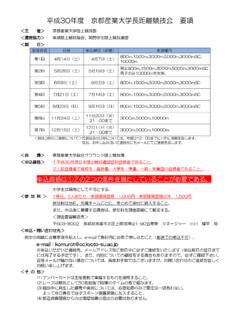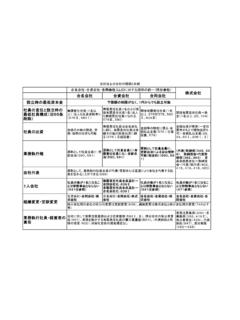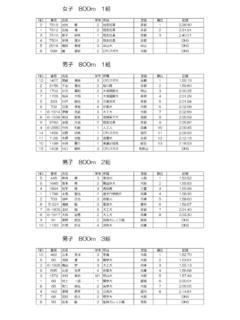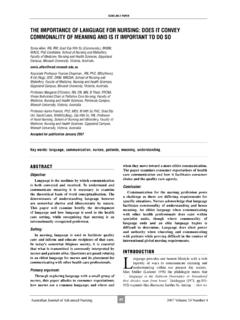Transcription of Professional English in Use: Marketing - 京都産業大学
1 June 2009 Volume 13, Number 1 Professional English in Use: MarketingProfessional English in Use: MarketingProfessional English in Use: MarketingProfessional English in Use: MarketingAuthor:Cate Farrall & Marianne Lindsley (2008)Cate Farrall & Marianne Lindsley (2008)Pub-lisher:Cambridge, UK: Cambridge University PressCambridge, UK: Cambridge University PressPagesISBNP ricePp. 144978-0-521-70269-0$30 global business climate has driven the necessity for English training in the past two decades (Scott, 1994; Ellis and Johnson, 1994). This book is a response to that need.
2 Written for intermediate and upper-intermediate level English learners, though perhaps useful for native English speakers as well, Professional English in Use: Marketing is for people from social, Professional or educational arenas who want to develop their mar-keting vocabulary and improve their content knowledge. As such, this book is a contri-bution to both workplace and classroom learning. Its 144 pages are divided into 50 the-matic units under 10 umbrella topics, each focusing on a different aspect of and : Customers and and relationsLearners who have used the In Use titles from Cambridge University Press before should find the layout of this book familiar.
3 Each unit consists of two facing pages, with key Marketing concepts and vocabulary on the left page and exercises on the right: , matching the words, cloze practices, matching the terminology with the right pictures, crossword puzzles. In general, the left page has sections indicated by a letter, usually A, B, and C, along with a clear title. For instance, in Unit 40, A: Word of mouth, B: Buzz TESL-EJ , June 2009 Farrall & Lindsley/Tu Page 1 of 4marketing and stealth Marketing , C: Electronic buss, D: Generating a buss (p. 86). The unit usually begins with an explanation of key terminology followed by applying that vo-cabulary, such as in short texts, diagrams, and tables.
4 To differentiate from the left page, exercises on the right page are coded in numerals. There are a variety of practice exer-cises short texts, gap fills, form-based word family charts, collocation matching, sen-tence completion, and tables to complete offered for learners to check their under-standing. Each unit ends with an 'over to you' section, an important feature of the book which gives learners speaking and writing opportunities to connect the vocabulary, ex-pressions, and content knowledge in the unit with their specific classroom or workplace situations.
5 Three examples are listed your wallet or purse. How many loyalty cards are you carrying? What advantages do these cards give you? (Unit 21, p. 49) of a product or a service that is usually sold by personal selling. Why is the sales method well suited to the product or service? What would you include in a sales kit for this product or service? (Unit 31, p. 69) that you are participating in a conference about branded content. Write a short speech entitled: 'Is branded content the future?' (Unit 38, p. 83)Farrall and Lindsley's book also provides at the back appendices, answer keys, and an index.
6 There are 12 appendices containing additional resources for using Marketing vo-cabulary in a Marketing about brand distribution and of out-of-home of newspaper rate itemsBesides preparing learners for working in Marketing , these appendices can also be ex-tremely useful for teachers as class supplements. The answer key gives answers to those kinds of exercises permitting only one response. An index lists all new words and ex-pressions (including their phonetic spelling and unit number) at the very end of the strength of this book is its systematic, easy-to-follow organization.
7 Because it is user-friendly for a wide audience, learners can personalize their learning pathway: either work through the book sequentially or pick topics that interest them in the table of con-TESL-EJ , June 2009 Farrall & Lindsley/Tu Page 2 of 4tents. After the basics, the topics become progressively more complex. Every unit in the book uses authentic sources from company websites and Marketing blogs to case studies and the trade press. While the authors don't give traditional Marketing tools short shrift, I commend its coverage of current Marketing trends: for example, online shopping, Internet advertising, and corporate significant aspect about Professional English in Use: Marketing is that it is a product of the Cambridge International Corpus.
8 With the help of corpus analysis, learn-ers of Marketing English no longer have to rely heavily on intuition to know what to say or write, to put isolated vocabulary into the right contexts. Instead, the corpus informa-tion presents what speakers and writers have actually said and written most frequently. In addition, the corpus extracts illustrate the vocabulary usage and grammatical struc-tures most problematic to learners of authors indeed have made a substantial contribution to students who want to learn specialized English for Marketing . However, their book has a few noticeable drawbacks.
9 First, a companion audio CD is not available with this book (nor with any of the Profes-sional English in Use titles). The CD would have provided an additional resource for learners to consult when they use the book without assistance from their teacher (or for self-study). It is essential for learners to create phonemic connections when they study new vocabulary (Birch, 2007). In addition, learners could use the audio CD to practice their reading fluency, ,. lower-proficiency learners could read along with the CD to practice their reading speed, and for listening comprehension.
10 Second, the subject focus of each unit might have been more accessible and understandable, particularly for learners at the lower end of a class, if some guiding questions had been provided at the beginning of each unit. It is important to activate learners' schema when introducing new vocabulary or new concepts, in order to prepare them for overall comprehension (Birch, 2007). A CD would also help learners develop their learning strategies, such as making predictions about what the text or vocabulary is going to be like (Garins & Red-man, 1986). Nevertheless, these blemishes can be remedied easily by an experienced classroom teacher who knows how to customize a unit and scaffold learning processes for his or her particular group of classroom teaching, teachers should not consume a vast amount of time explaining and giving definitions of the vocabulary.














